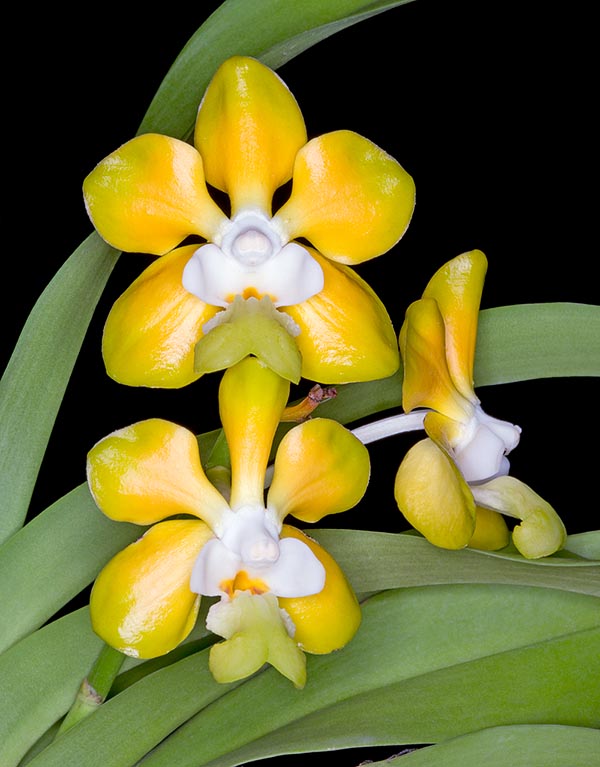Family : Orchidaceae

Text © Pietro Puccio

English translation by Mario Beltramini

Vanda denisoniana is native to Laos, Myanmar, Thailand and Vietnam. Epiphyte with 1 m stems and 12-15 cm racemose inflorescences with 3-8 fleshy flowers that may reach 7 cm of diametre © Giuseppe Mazza
The species is native to Laos, Myanmar, Thailand and Vietnam where it lives on the trees of the pluvial forests on the Arakan Mountains, between the 700 and the 1000 m of altitude.
The name of the genus is that in Sanskrit of the Vanda tessellata; the species is honoured to Lady Denison, wife of Albert Denison Londesborough (1805-1860), famous collector of orchids.
Common names : euang nang nouane (Laos), thayet htaew (Myanmar); sam poi khun tan, sam poi luang, ueang sam poi dong (Thailand); lan thanhnga, mỹ dung dạ hương (Vietnam).
The Vanda denisoniana Benson & Rchb.f. (1869) is a monopodial epiphytic species with erect stem, that may reach 1 m of height with a diametre of about 1 cm, hidden by the imbricate foliar bases, from which depart robust aerial roots. Distichous alternate leaves, curved, nastriform, with unevenly bilobed apex, 15-35 cm long and 1,6-3 cm broad, of dark green colour.
Ascending axillary racemose inflorescences, 12-15 cm long, bearing 3-8 fleshy flowers, of 4-7 cm of diametre, with sepals and petals of colour varying from white, cream, pale yellow, golden yellow to yellowish brown and white labellum with a usually greenish spot. Dorsal sepal oblong-spatulate, 2,5 cm long and 1,3 cm broad, ovate lateral sepals, 2,2 cm long and 1,8 cm broad, spatulate petals, 2,5 cm long and 1,5 cm broad, trilobed labellum, 3,2 cm long and 1,6 cm broad, with erect lateral lobes and pandurate (violin shaped) median lobe with five crests at the base. The long lasting flowers, one month and more, emit an intense scent after the sunset that stops during the night.
It reproduces by seed, in vitro, and micropropagation.
Orchid with particularly attractive flower, requires a slightly shaded position, high temperatures in summer, 22-32 °C, along with high humidity, 75-85%, cooler in winter, 16-26 °C, with lowest night ones not less than 12 °C, even if it may stand some degrees less for a short time, and humidity around the 60% ; the movement of the air must be constant all the year round.
Regular and abundant waterings preferably in the morning, even daily for the plants with bare root, from late spring to autumn, and nebulizations of the roots getting out from the pot or the basket, more spaced during the rest of the year, but with never leaving completely dry, using rainwater, demineralized or by reverse osmosis at ambient temperature. Biweekly fertilizations during the growth period with a balanced product, with microelements, specific for orchids, at ½ – ¼ of the dosage suggested in the instructions.
It is preferably cultivated in baskets or suspended pots without any substratum, with bare root, as well as with a particularly draining and aerated compost formed, for instance, by fragments of earthenware, medium-big sliced bark or coir, and charcoal. The roots do not love being disturbed, therefore the repottings are to be done only when strictly necessary, by the vegetative restart.
The species is reported in the appendix II of the CITES (species whose trade is internationally ruled).
Synonyms : Vanda denisoniana var. tessellata Guillaumin (1933).
→ For general notions about ORCHIDACEAE please click here.
